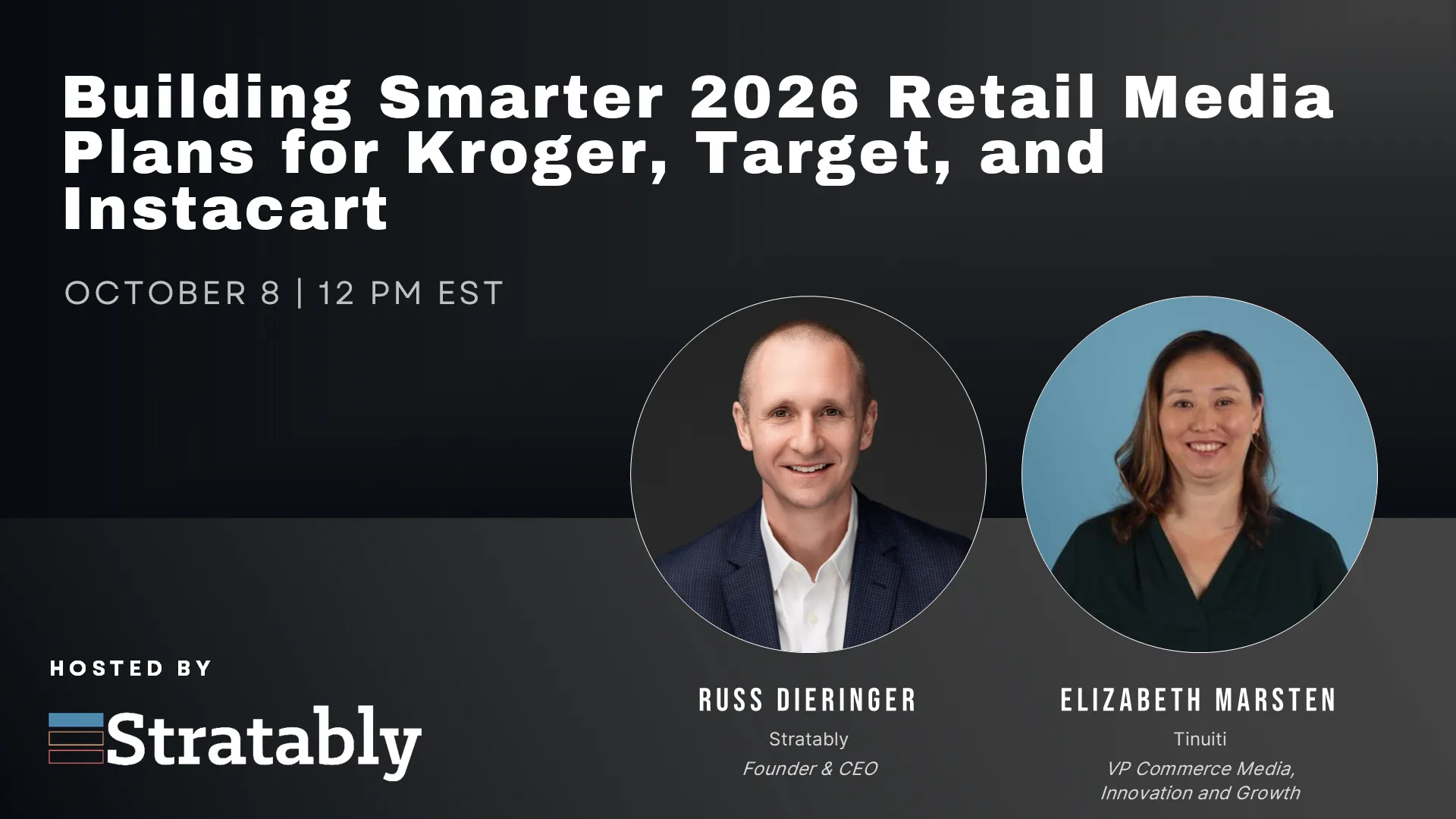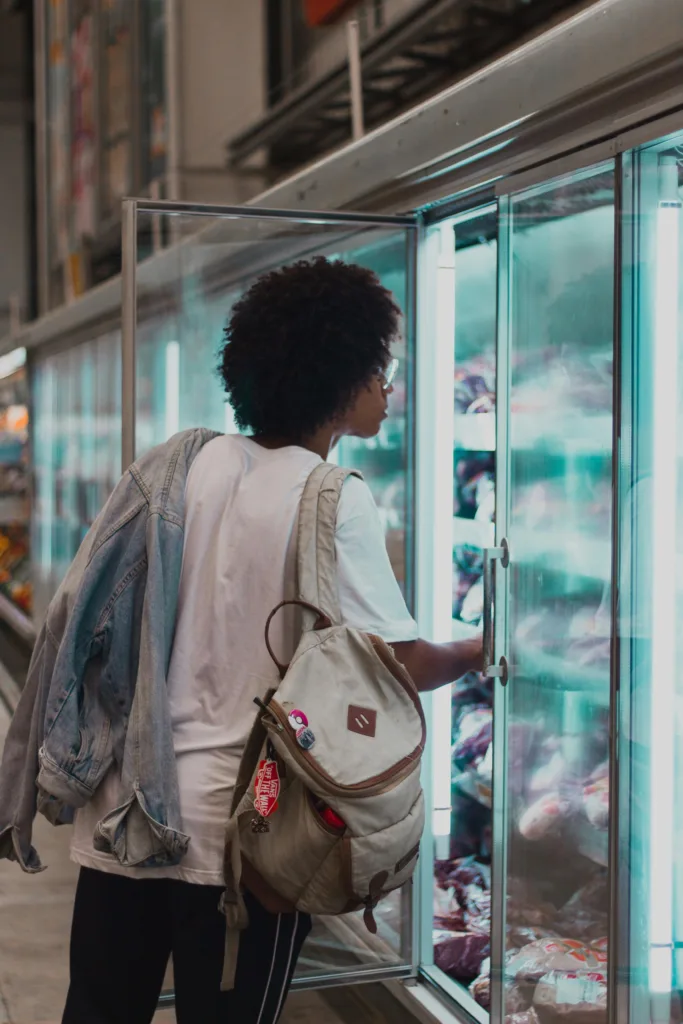TL;DR: Kroger, Target, and Instacart are evolving in ways that make “one-size-fits-all” planning inefficient. Brands must tailor spend to each network’s maturity, double down on paid search efficiency before expanding offsite, and measure every dollar against incremental growth.
3 minute read
Retail media has become one of the defining battlegrounds for growth in consumer brands. What began as a narrow search-driven discipline is now a complex, full-funnel ecosystem where every retailer is racing to build differentiated data assets, advertising capabilities, and monetization models. Yet, despite the surface similarities across networks, the underlying economics and opportunities vary by retailer and brands have limited budgets that they need to optimize, meaning they must make tough calls on where to invest their limited retail media budgets.
To help brands prepare for 2026, Stratably hosted a session with Elizabeth Marsten, VP of Commerce Media, Innovation and Growth at Tinuiti. The discussion examined how Kroger, Target, and Instacart are evolving their retail media offerings, what structural shifts occurred in 2025, and how those changes should shape 2026 plans.
Marsten drew from extensive practitioner experience to identify where each retailer is making meaningful progress and where execution challenges persist.
For brands allocating millions of dollars across these networks, success in 2026 will depend on aligning investment strategies with each retailer’s commercial priorities, data maturity, and shopper dynamics.
Russ’s Key Takeaways
- Paid search first, then offsite (still!): Advertisers continue to start at each network by maximizing the paid search opportunity, and only then expand to additional ad activations, like offsite. This offsite reluctance is partly due to inconsistency with metrics like NTB, difficulty executing managed and self-service offerings together, measurement challenges, and technology stack changes. In addition, many brands maintain a siloed approach towards media, keeping “digital teams” focused on offsite and “retail media teams” focused on onsite activations, thereby missing opportunities to compare and contrast performance between traditional digital ad platforms and retailers’ capabilities.
- Maturity gaps remain across networks: Despite every retailer wanting brands’ media budgets, not all networks are created equal, with Instacart, Kroger, and Target all demonstrating different strengths and weaknesses. Brands should calibrate expectations and investment levels accordingly, focusing on channel depth and proven ROI before expanding to more networks. Our research suggests these three networks are a focus amongst CPG brands, as are Amazon and Walmart.
- Demand performance for anything charged: If a network is charging for a beta feature or new ad format, it should demonstrably outperform alternatives before a brand commits incremental dollars. Early participation can pay off, but only when tied to clear ROI measurement frameworks, and brands are right to be skeptical of paying for unproven capabilities.
- Incrementality KPIs still elusive: Despite new reporting tools, metric consistency and availability remain major friction points across RMNs. This has been echoed in Stratably’s prior research, with only 16% of brands expressing confidence in assessing retail media incrementality.
- Target RMS updates: Since moving off Criteo, advertisers are seeing stronger ROAS and Roundel has added a third slot to search and category pages. It has also launched Precision Plus, which is an AI powered offsite capability under its managed service offering (somewhat akin to Amazon’s Brand+ and Performance+ offerings, Google’s Pmax offering, etc.). Tinuiti is also seeing good results leaning into “retailer moments”.
- Kroger onsite updates: It’s recommended to lean into onsite self-service capabilities and to keep PLAs always on. The challenge with PLAs is they hit a ceiling quickly, requiring advertisers to spend on less performant TOAs. Promoted product carousels have also been introduced, and are the next best option beyond PLAs (but could benefit from improved targeting). Brands are also evaluating Kroger’s video capabilities and related costs to participate.
- Kroger’s tech overhaul creates long-term advantage: The migration to new systems has slowed some campaign reporting and measurement speed, but it’s believed to be building a foundation for more scalable self-service tools and richer audience segmentation. Brands also remain hungry for new-to-brand measurement.
- Avoid cutting Instacart budget: While Instacart is one of the first to get cut in media budgets (often because brands can’t cut retail media commitments made in omni JBPs), Tinuiti recommends brands resist the urge. Sponsored Products remain the first avenue to maximize, but Tinuiti is seeing Instacart make meaningful progress on 1P data partnerships, such as The Trade Desk integration (which practically speaking just got started in July). Brands should reserve small budgets for controlled offsite experimentation and push Instacart for incrementality reporting.
- The CPM bubble is real: Onsite display and video CPMs are high ($30+ in some cases) without proportional gains in incrementality. Brands should scrutinize these rates versus social or open-web alternatives, demanding transparent benchmarks before committing to pilots or managed-service minimums.
- Self-serve and transparency are bright spots: Instacart and Kroger are lowering entry barriers and publishing more transparent CPM and budget requirements, potentially signaling a shift from JBP-heavy managed buys to tactical flexibility. This will reward brands that can build internal readiness for self-serve execution.
Russ’s Final Thought
We’re entering a phase where “retail media sophistication” will be defined less by how much brands spend and more by how precisely they allocate those dollars across fragmented ecosystems.
Despite brands’ desire for convergence, in the form of ad types, measurement, reporting, and so on, each retailer is evolving in its own direction, shaped by distinct shopper missions, data assets, and profitability pressures. In other words, all retail media networks are not equal, and this divergence represents both complexity and opportunity for consumer brands.
In 2026, the best-performing brands will treat each network as a distinct opportunity, manage budgets with the same rigor as trade or other digital media investments, and hold retailer partners accountable for measurable value creation.



